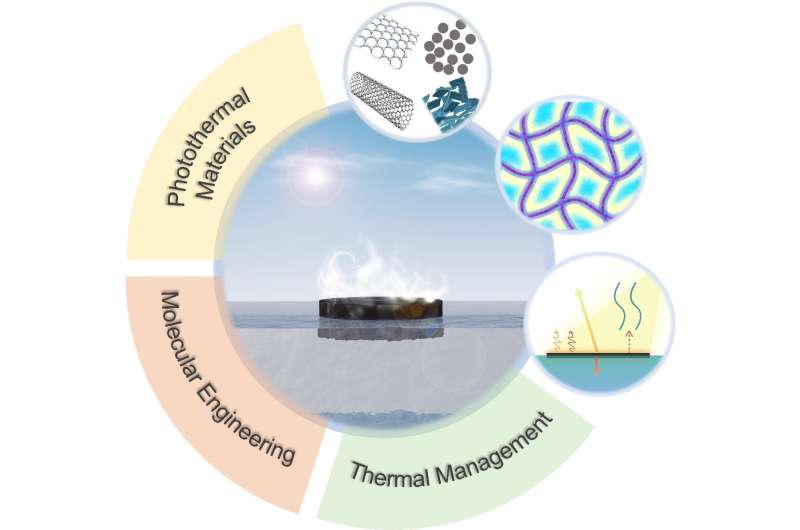
Freshwater is essential for human life and the scarcity of freshwater is a critical issue in parts of the world today. In recent years, scientists have put great efforts into developing desalination technologies so that clean water can be produced from seawater. Interfacial solar evaporation (ISE) is a technology that holds promise for helping to relieve worldwide freshwater shortages. A team of researchers has undertaken a review study of the strategies available for constructing efficient ISE systems.
Their work is published in the journal Nano Research Energy.
The team’s paper examines the energy nexus in two-dimensional and three-dimensional solar evaporators and reviews the strategies for design and fabrication of highly efficient ISE systems. Their summarized work offers perspectives for guiding the future design of ISE systems toward practical applications.
ISE is a desalination technology that produces freshwater through a process that is both environmentally friendly and sustainable. With this technology, solar energy is harnessed to evaporate and purify water. The technology uses photothermal evaporators to convert heat from sunlight to be localized at the evaporation surface for efficient vapor generation instead of dissipation into the bulk water and environment.
Traditional desalination technologies such as membrane filtration and thermal distillation consume large amounts of electricity derived from fossil fuels, so they are not considered to be environmentally friendly. Scientists continue to search for new desalination technologies that use green and sustainable energy sources.
Recent work in ISE technologies has been focused primarily on optimizing energy management. Researchers have improved photothermal material and evaporator design with a goal of attaining more efficient energy use. This is achieved through three pathways: minimizing the energy loss from evaporation system to the environment, extending the energy input from the environment to enhance the evaporation process, and reducing evaporation enthalpy so the vaporization process is more efficient.
The team’s review systematically summarizes these pathways for enhancing practical solar evaporation performance. “We clearly demonstrate that the evaporation rate can be significantly enhanced by either applying materials with highly efficient light-to-heat conversion or structure design of state-of-art evaporators with smart energy management strategies,” said Li Yu, a professor at the Shenzhen Technology University.
“The main principles for achieving highly efficient solar evaporation include avoiding energy loss from the evaporation systems to the environment, expanding energy input from the surrounding air and bulk water, making full use of the existing energy already in the evaporation systems, and lowering the evaporation enthalpy,” said Haolan Xu, a professor at the University of South Australia.
The team offers five recommendations to be considered in moving next-generation ISE systems toward practical applications:
The first recommendation is to introduce new energy sources for ISE. Because solar light intensity significantly varies, it is important to explore new energy sources for all-day, all-weather, and all-season ISE systems.
The second recommendation is to continuously explore novel photothermal materials. The team suggests that the next-stage development of photothermal materials needs to focus on maximizing the use of thermal energy in both macroscale and micro-nanoscale.
The third recommendation is to explore innovative designs for photothermal evaporators. These next-generation evaporators should maximize energy harvest and water evaporation, while improving the water flow to ensure balanced water supply and evaporation.
The fourth recommendation is to improve water production in a limited space. In an ISE system, water evaporation and collection are two main parts. Although researchers have achieved very high solar evaporation rates, highly efficient water collection is rarely reported. Next-generation ISE systems need to have an excellent water evaporation module and an efficient vapor condensing module that fits in a compact space.
The team’s fifth recommendation focuses on the importance of developing large-scale ISE systems for practical applications, such as seawater desalination and wastewater treatment. They suggest that small evaporators be produced as units and assembled to form a larger interconnected system.
Looking ahead the team sees the potential for ISE technologies providing practical applications for meeting the freshwater scarcity problem. “In the current context of worldwide clean water shortages and advocacy for low carbon emission technologies, ISE is now accepted as one of the most promising technologies to solve the global clean water scarcity issues. However, there is still a long way to go to push forward the real-world applications of ISE technology,” said Yingying Zhang, a professor at Tsinghua University.